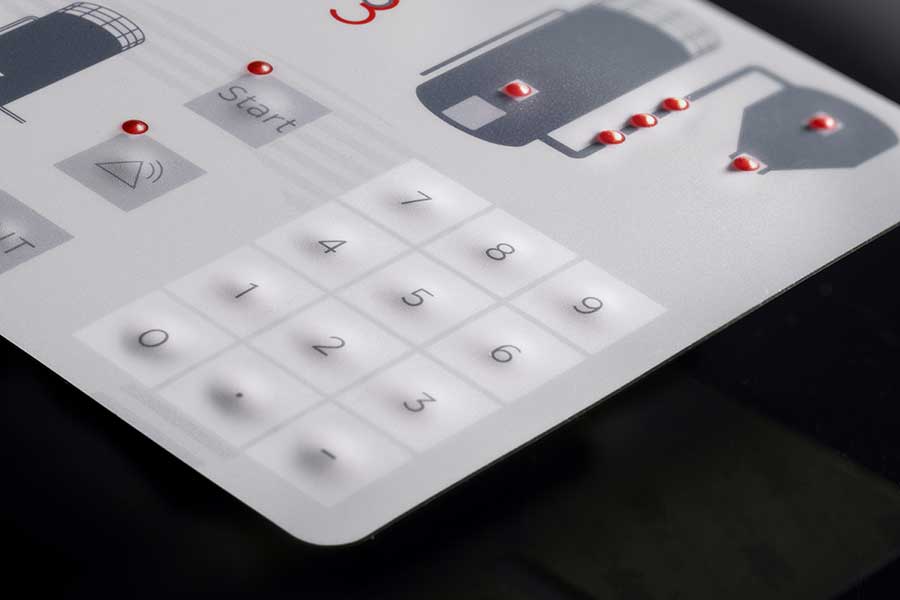How to Make Sure Long Life and Reliability with a High-Quality Membrane Switch
How to Make Sure Long Life and Reliability with a High-Quality Membrane Switch
Blog Article
Comprehending the Performance of Membrane Layer Switches Over for Interface Tools
The performance of membrane layer changes stands for a significant improvement in user interface style, combining effectiveness with visual flexibility. As sectors increasingly prioritize individual experience, recognizing the nuances of membrane layer button technology ends up being crucial.
What Are Membrane Switches?
Membrane layer buttons are innovative interface gadgets that assist in individual communication with electronic equipment. These versatile elements are composed of several layers, consisting of a visuals overlay, spacer, and a published circuit layer. The layout enables a seamless integration into various electronic devices, improving both the aesthetic and practical elements of individual interfaces.
Membrane switches are typically utilized in a vast array of applications, from family home appliances to commercial machinery and medical devices. Their building and construction commonly includes a thin account, making them an excellent selection for portable layouts. The responsive responses supplied by these buttons can be engineered to satisfy details user choices, ensuring reliable interaction in between the customer and the gadget.
Toughness is one more significant benefit of membrane layer switches, as they are resistant to dust, dampness, and chemicals, which improves their lifespan in demanding settings. Furthermore, these buttons can be tailored in terms of form, dimension, and graphic layout, enabling branding and user-specific features. Overall, membrane layer changes stand for a sensible option for enhancing customer experience in electronic devices, incorporating performance with visual charm in an efficient way.
How Membrane Layer Changes Work
Operating on a straightforward concept, membrane changes use a split construction to register individual input efficiently. Each button is composed of several layers, including a published circuit layer, a spacer layer, and a leading visuals layer, which are created to collaborate effortlessly. When a user presses the leading layer, it presses the spacer layer, bringing the conductive aspects of the circuit layer right into call with each other.
This call creates a closed circuit, indicating the tool to perform a details function. The layout permits different arrangements, including tactile comments, which can boost the individual experience by giving a physical sensation upon activation. The materials utilized in membrane layer buttons commonly include adaptable substrates, such as polyester or polycarbonate, which ensure toughness and strength against damage.

Key Advantages of Membrane Switches

Another considerable benefit is their compactness. Membrane buttons are thin and light-weight, which allows makers to save room in their gadgets without sacrificing capability. This function is particularly beneficial in applications where weight and quantity are vital considerations.
In addition, membrane buttons are resistant to dirt, moisture, and chemicals, boosting their sturdiness. This resilience prolongs their lifespan and minimizes the need for regular replacements, leading to price savings with time.
Moreover, the tactile feedback supplied by membrane buttons can be optimized to enhance customer interaction. They can include attributes such as raised buttons or distinct clicks, improving functionality and customer experience.
Applications Across Industries
Interface gadgets using membrane layer switches are common in a vast range of sectors, showcasing their adaptability and functionality. Membrane Switch. In the medical industry, membrane layer buttons are important to tools such as diagnostic equipment and client surveillance systems, where their durability and ease of cleaning are crucial for maintaining hygiene requirements. In the automobile market, these buttons are used in control panel controls and infomercial systems, giving a streamlined and modern-day interface for users.
Additionally, the consumer electronic devices industry gain from membrane layer buttons in appliances and portable tools, where small style and easy to use user interfaces enhance try this site user experience. Industrial applications also utilize membrane layer switches over for control board in machinery and automation systems, highlighting their robustness and resistance to severe atmospheres.
In the aerospace and defense sectors, membrane layer switches are utilized in cockpit controls and tools, where integrity and efficiency under extreme conditions are extremely important. In addition, the video gaming industry increasingly includes membrane layer switches in controllers and arcade machines, adding to an his explanation appealing user experience. On the whole, the convenience of membrane layer changes enables their prevalent use across countless fields, highlighting their significance in contemporary user interface layout.
Future Patterns in Membrane Change Technology

Furthermore, the usage of innovative materials, such as polycarbonate and polyester films, is anticipated to climb, providing enhanced durability and resistance to ecological stressors. These materials add to the total long life of membrane switches, making them suitable for harsher industrial applications.
Furthermore, the unification of clever technology, including IoT connectivity, will allow membrane switches to communicate with other gadgets and systems, promoting an extra interactive customer experience. This trend aligns with the growing demand for wise tools throughout various sectors, from healthcare to consumer electronics.
Lastly, modification options are anticipated to expand, allowing manufacturers to create bespoke solutions customized to details customer demands and choices. These growths will certainly position membrane switches as essential parts in the advancement of interface innovation.
Conclusion
In final thought, membrane changes stand for a critical development in individual interface innovation, offering a trustworthy and functional service for diverse electronic applications. As advancements in material scientific research visite site and touch sensing innovations proceed, the functionality and applicability of membrane buttons are anticipated to expand, strengthening their value in modern electronic tools.
Report this page